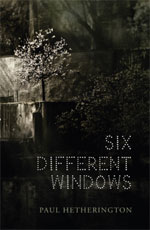
you’ve been carelessly worn, an irresistible attraction
Six Different Windows by Paul Hetherington
UWA Press, 2013
As the title of Paul Hetherington’s compelling and richly imagined new collection suggests, and the six sections confirm, Six Different Windows offers an array of contrasting perspectives on experience. Framed visions: all of them to some extent haunted, or tainted.
In the opening section, ‘Corrugations’, the long-buried potency of childhood is unearthed, still charged with all the thisness of the world (not that I want to fall into the trap of assuming that these ‘memories’ are all autobiographically authentic). The excitement of the world of childhood and its dangerous bravado are wonderfully conjured in ‘Early Ambition’:
to climb the knotted rope that hung over the brown folds of the wrinkling river to fall so the body became a missile, aimed at the turbid hole between rocks and river bank
Adventures, family difficulties, school trouble, longings and rivalries: there is a mingling of the beautiful and the ugly in these vignettes, of Eden soiled by squalor yet remaining somehow Edenic because of the child’s willingness to see it so, or inability to see it otherwise.
This notion of the tainted earthly paradise, implicit in ‘Corrugations’, is taken up explicitly in the next section ‘Five Abstractions of Blue’. Here the figure of the artist (painter, musician, writer) recurs in several poems, the representative of our transformative engagement with the world.
The word ‘forage’ seemed a kind of answer
He was reminded how finding words
demanded a looking about
to bring something back
a scent or something dragged from the ground
(‘Forage’)
Yet for the eponymous artist in ‘Artist’, although ‘The Eden he had so often painted shone like a seer’s gift’, it was ‘everywhere tainted by human absurdity’.
The artist is replaced by the tourist, or traveller, in the third part, which shares the title of the book. What Kevin Hart has described as the ‘dislocations and fitful illuminations offered by travel’ are scrutinised and memorably embodied. The linguist – in the poem of that title – seems addicted to travel in search partly of ‘how meaning/ is everywhere differently made’, partly of Shangri-la, though it ‘might be your death’; the protagonist of ‘Through a Window, Looking Back’ longs for ‘an absence of needing to be/ what others required’, and wants ‘to stay strange to herself’. Changes of scene and disorientation: these two aspects of wanderlust are economically and appropriately embraced by the French word dépaysement, the title of the last poem in this section.
The fourth section, ‘Afterlight: Icarus and Ariadne’, takes us back to the pre-historical archetypes of myth, with re-imaginings – partly in modern dress (‘A Contemporary Icarus’) of those ancient tales, before ‘The Vanished Villages’, part five, presents us with the horrors of actual history – in what is in some ways the most confronting and arresting of the sections, with its vivid accounts of the destruction of Pompeii, starvation in Greenland, and various sacrificial victims. It also presents us with our own ambiguous position in relation to these remains: a preserved corpse’s ‘uncurling fingers might take a trowel/ to dig inside her broken world and raise her dead society as one…/ to dismay our intrusiveness (‘Archaeological Museum’).Yet we are constantly aware of ‘the distance between/ the culture that made them/ and our desires’.
The final section, ‘Findings, Keepings’, returns to the present, world of familial relations in a known landscape, but one no less inhabited (haunted?) by the past, by a father who left and whose daughter ‘remembers nothing of his love,/… quizzing her own blood (‘Puzzle’); of the poet listening ‘to the body/ of the first girl I made love to’ (‘Blood’); by dispossessed Aborigines and the settlers who seemed to have ‘risen out of the clay,/…one mythological morning,/ to take the old and dreaming world away’ (‘The Old and Dreaming World’).
What is it that holds all these framed vistas together? Looking, obviously. Looking out, as one does through a window, but, since these are all windows on time, looking back, on childhood, on places visited, physically or in the imagination, on history, on myth. And since, as ‘Archaeological Museum’ puts it, ‘The past adheres like glue in our bones;/ culture pervades us like a virus’, the past is also the present, and they are us. The image of excavation, too, pertinent to archaeology, is recurrent, and in unearthing the past ‘we are digging in the marrow/ of our wanting bodies’.
Both moving and unsettling in content, striking in expression and imagery, this is a rewarding and memorable collection.













